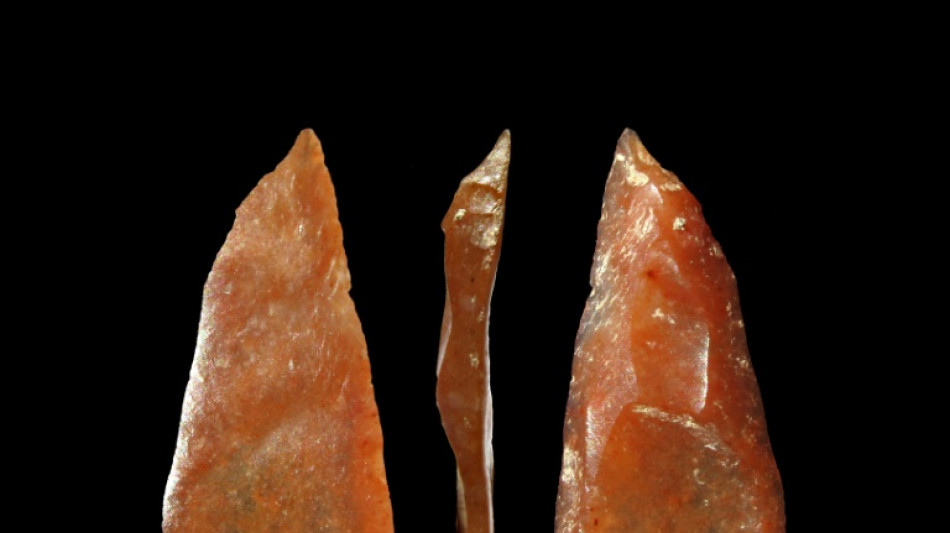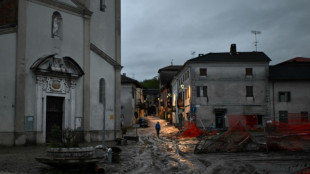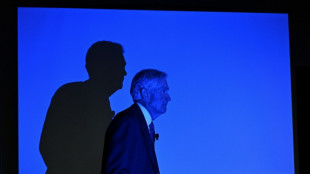
-
 PSG beat Le Havre to stay on course for unbeaten Ligue 1 season
PSG beat Le Havre to stay on course for unbeaten Ligue 1 season
-
Man City close in on Champions League with Everton late show

-
 14-year-old Vaibhav Suryavanshi becomes youngest IPL player
14-year-old Vaibhav Suryavanshi becomes youngest IPL player
-
Barca make stunning comeback to beat Celta Vigo in Liga thriller

-
 Zverev sets up birthday bash with Shelton in Munich
Zverev sets up birthday bash with Shelton in Munich
-
Man City boost top five bid, Southampton snatch late leveller

-
 US Supreme Court intervenes to pause Trump deportations
US Supreme Court intervenes to pause Trump deportations
-
Alcaraz and Rune race into Barcelona final

-
 US, Iran to hold more nuclear talks after latest round
US, Iran to hold more nuclear talks after latest round
-
Man City close in on Champions League thanks to Everton late show

-
 Bayern close in on Bundesliga title with Heidenheim thumping
Bayern close in on Bundesliga title with Heidenheim thumping
-
Tunisia opposition figures get jail terms in mass trial

-
 Putin announces 'Easter truce' in Ukraine
Putin announces 'Easter truce' in Ukraine
-
McLaren duo in ominous show of force in Saudi final practice

-
 Afghan PM condemns Pakistan's 'unilateral' deportations
Afghan PM condemns Pakistan's 'unilateral' deportations
-
Iran says to hold more nuclear talks with US after latest round

-
 Comeback queen Liu leads US to World Team Trophy win
Comeback queen Liu leads US to World Team Trophy win
-
Buttler fires Gujarat to top of IPL table in intense heat

-
 Unimpressive France stay on course for Grand Slam showdown
Unimpressive France stay on course for Grand Slam showdown
-
Shelton fights past Cerundolo to reach Munich ATP final

-
 Vance and Francis: divergent values but shared ideas
Vance and Francis: divergent values but shared ideas
-
Iran, US conclude second round of high-stakes nuclear talks in Rome

-
 Dumornay gives Lyon first leg lead over Arsenal in women's Champions League semis
Dumornay gives Lyon first leg lead over Arsenal in women's Champions League semis
-
Trans rights supporters rally outside UK parliament after landmark ruling

-
 Rune destroys Khachanov to reach Barcelona Open final
Rune destroys Khachanov to reach Barcelona Open final
-
From Messi to Trump, AI action figures are the rage

-
 Vance discusses migration during Vatican meeting with pope's right-hand man
Vance discusses migration during Vatican meeting with pope's right-hand man
-
Afghan FM tells Pakistan's top diplomat deportations are 'disappointment'

-
 British cycling icon Hoy and wife provide solace for each other's ills
British cycling icon Hoy and wife provide solace for each other's ills
-
Money, power, violence in high-stakes Philippine elections

-
 Iran, US hold second round of high-stakes nuclear talks in Rome
Iran, US hold second round of high-stakes nuclear talks in Rome
-
Japanese warships dock at Cambodia's Chinese-renovated naval base

-
 US Supreme Court pauses deportation of Venezuelans from Texas
US Supreme Court pauses deportation of Venezuelans from Texas
-
Pakistan foreign minister arrives in Kabul as Afghan deportations rise

-
 Heat and Grizzlies take final spots in the NBA playoffs
Heat and Grizzlies take final spots in the NBA playoffs
-
Iran, US to hold second round of high-stakes nuclear talks in Rome

-
 Humanoid robots stride into the future with world's first half-marathon
Humanoid robots stride into the future with world's first half-marathon
-
Migrant's expulsion puts Washington Salvadorans on edge

-
 Plan for expanded Muslim community triggers hope, fear in Texas
Plan for expanded Muslim community triggers hope, fear in Texas
-
Pakistan foreign minister due in Kabul as deportations rise

-
 White House touts Covid-19 'lab leak' theory on revamped site
White House touts Covid-19 'lab leak' theory on revamped site
-
Dodgers star Ohtani skips trip to Texas to await birth of first child

-
 US senator says El Salvador staged 'margarita' photo op
US senator says El Salvador staged 'margarita' photo op
-
Ford 'adjusts' some exports to China due to tariffs

-
 Thomas maintains two-shot lead at RBC Heritage
Thomas maintains two-shot lead at RBC Heritage
-
US to withdraw some 1,000 troops from Syria

-
 Four killed after spring storms wreak havoc in the Alps
Four killed after spring storms wreak havoc in the Alps
-
Spurs' Popovich reportedly home and well after 'medical incident'

-
 Trump goes to war with the Fed
Trump goes to war with the Fed
-
Celtics chase second straight NBA title in playoff field led by Thunder, Cavs


Study places Homo sapiens in Europe earlier than thought
Homo sapiens ventured into Neanderthal territory in Europe much earlier than previously thought, according to an archaeological study published in Science magazine on Wednesday.
Up to now, archaeological discoveries had indicated that Neanderthals disappeared from the European continent about 40,000 years ago, shortly after the arrival of their "cousin" Homo sapiens, barely 5,000years earlier and there was no evidence of an encounter between these two groups.
The new discovery, by a team of archaeologists and palaeoanthropologists led by Ludovic Slimak of Toulouse University, pushes back the arrival of Homo sapiens in Western Europe to around 54,000 years ago.
Another remarkable finding of the research is that the two types of humans alternated in inhabiting the Mandrin cave in what is now the Rhone region of southern france.
The Mandrin site, first excavated in 1990, includes layer upon layer of archaeological remains dating back over 80,000 years.
"Mandrin is like a kind of neandertalian Pompeii, without catastrophic events, but with continuous filling of sands in the cave deposited progressively by a strong wind, the Mistral," Slimak told AFP.
His team uncoevered a layer, known as the "E layer", containing at least 1,500 cut flint points, more finely executed than the points and blades in the layers above and below.
Very small in size, some of them less than a centimetre in length, these points "are standardised, to the nearest millimetre, something we haven't seen at all with Neanderthals," said Slimak, a specialist in Neanderthal societies.
These, he explained, were probably arrowheads, unknown in Europe at that time.
He attributes this production to a culture called Neronian, linked to several sites in the Rhone area.
- Milk tooth discovery -
In 2016, Slimak and his team visited the Peabody Museum in Harvard to compare their discoveries with a collection of carved fossils from the Ksar Akil site at the foot of Mount Lebanon, one of the major sites of the expansion of Homo sapiens to the east of the Mediterranean.
The similarity between the techniques used convinced Slimak that the findings at the Mandrin site were the first traces of Home Sapiens found in Europe.
A milk tooth found in the "E layer" confirmed his suspicions.
In all researchers found nine teeth at the Mandrin cave site, belonging to six individuals.
These ancient teeth were entrusted to Clement Zanolli, a palaeoanthropologist at the University of Bordeaux.
Using microtomography, similar to medical scanning technology, the verdict was clear.
The milk tooth from the "E" layer" was the only modern human tooth found at the site.
That "fossil molar from a modern human child provides the earliest known evidence of modern humans in western Europe", the Natural History Museum in London said in a statement.
- Co-existence? -
The archaeological team then used a pioneering technique, fuliginochronology, which analyses layers of soot impregnating the walls of a cave and the traces of ancient fires.
The reachers demonstrated that "this Modern human population occupied this Rhone territory for some 40 years," said Slimak.
At some point, the two populations either co-existed in the cave or on the same territory, the researcher concluded.
He imagines that Neanderthals could have served as guides to Homo Sapiens to lead him to the best sources of flint available, some of which were located up to 90 kilometres (55 miles away.
"Nothing new under the sun… This is precisely what happened when Europeans began the colonization of the Americas or Australia," he noted.
"The findings from Mandrin are really exciting and are another piece in the puzzle of how and when modern humans arrived in Europe,? concludes Professor Chris Stringer, co-author of the study and a specialist in human evolution at the Natural History Museum in London.
"Understanding more about the overlap between modern humans and other hominins in Eurasia is vital to understanding more about their interactions, and how we became the last remaining human species," he added.
This overlap, which was evident in Mandrin, now places the Rhone region as a "major migration corridor (for Homo sapiens) enabling them to reach the Mediterranean and continental European areas", said Slimak, who promises more discoveries from the Mandrin site.
W.Lapointe--BTB




